› Forums › 2022 Summer Courses › Reading-Year567-Tue
- This topic has 148 replies, 9 voices, and was last updated September 20, 2022 by
Beth.
-
AuthorPosts
-
-
at 18:11 #25042
Beth
ParticipantSummary for Lesson 1
In today’s class we began our lessons on our first book, Uncle Tom’s Cabin by Harriet Beecher Stowe. We began by discussing the class’s opinion of the novel, touching on the sensitivity of the subject matter and thinking about how to place the book in its historical context. We spoke about what the class knew about the 1850s in the USA, covering important details such as the Civil War and slavery, before learning about this in relation to the novel. Finally we spoke about how understanding the way the book was published is crucial in uncovering the political intentions of the book, finishing with a discussion on the ways in which the history (and Harriet Beecher Stowe’s own life) influence our understanding of the novel. Excellent work from everyone today- I was really impressed by the knowledge, energy and enthusiasm on display. Well done class- keep up the great work and I’ll see you next week 🙂
Video on the history: https://www.youtube.com/watch?v=Z08N7pqr_cw
Homework

Attachments:
You must be logged in to view attached files. -
at 07:18 #25046
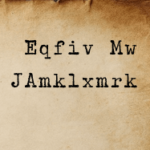 AmberParticipant
AmberParticipantDear Beth,
Thank you for the glorificnt lsson! 😉 🙂 * (^0^)*
————————————————————————————————————————————–
“Half the misery in the world comes of want of courage to speak and to hear the truth plainly and in a spirit of love.”
— Harriet Beecher StoweAttachments:
You must be logged in to view attached files.-
at 18:39 #25122
-
-
at 17:19 #25071
Ethan
ParticipantHello Beth,
I really enjoyed your lesson on Tuesday! Please find my homework attached, thanks!
Ethan
Attachments:
You must be logged in to view attached files.-
at 18:47 #25124
-
-
at 16:45 #25095
Yichen
ParticipantHi Beth,
This is my homework. Thanks for the wonderful lesson!
Attachments:
You must be logged in to view attached files.-
at 18:55 #25126
-
-
at 21:36 #25103
Dudee
ParticipantSorry for slightly late submission, thanks for the excellent lesson, homework attached.
Attachments:
You must be logged in to view attached files.-
at 19:04 #25128
-
-
at 22:57 #25137
Yinuo Li
ParticipantSorry for the lateness of my submission. My work is here
Attachments:
You must be logged in to view attached files.-
at 15:35 #25144
-
-
at 18:14 #25152
Beth
ParticipantSummary for Lesson 2
Today we dug deeper into Uncle Tom’s Cabin, debating and discussing elements of the book such as the central themes and moral ideas behind the story. We began with a discussion of themes before moving on to a character analysis of the three slave owners in the book- thinking about what the progression of their cruelty tells us about Stowe’s message and touching on the notion of whether presenting slave owners such as Shelby in a more positive light undermines Stowe’s anti-slavery ideas. Finally we analysed a passage from the end of the book, thinking about how suspense is created and debating the notion of whether Tom represents Jesus. Everyone worked beautifully today, offering loads of creative and mature ideas about the symbolic and thematic content of the novel. Their analysis of the text at the end was outstanding and I loved hearing all their detailed and unique ideas about the way in which Stowe writes and creates tension. Very well done everyone- keep up the amazing work! 🙂
Homework
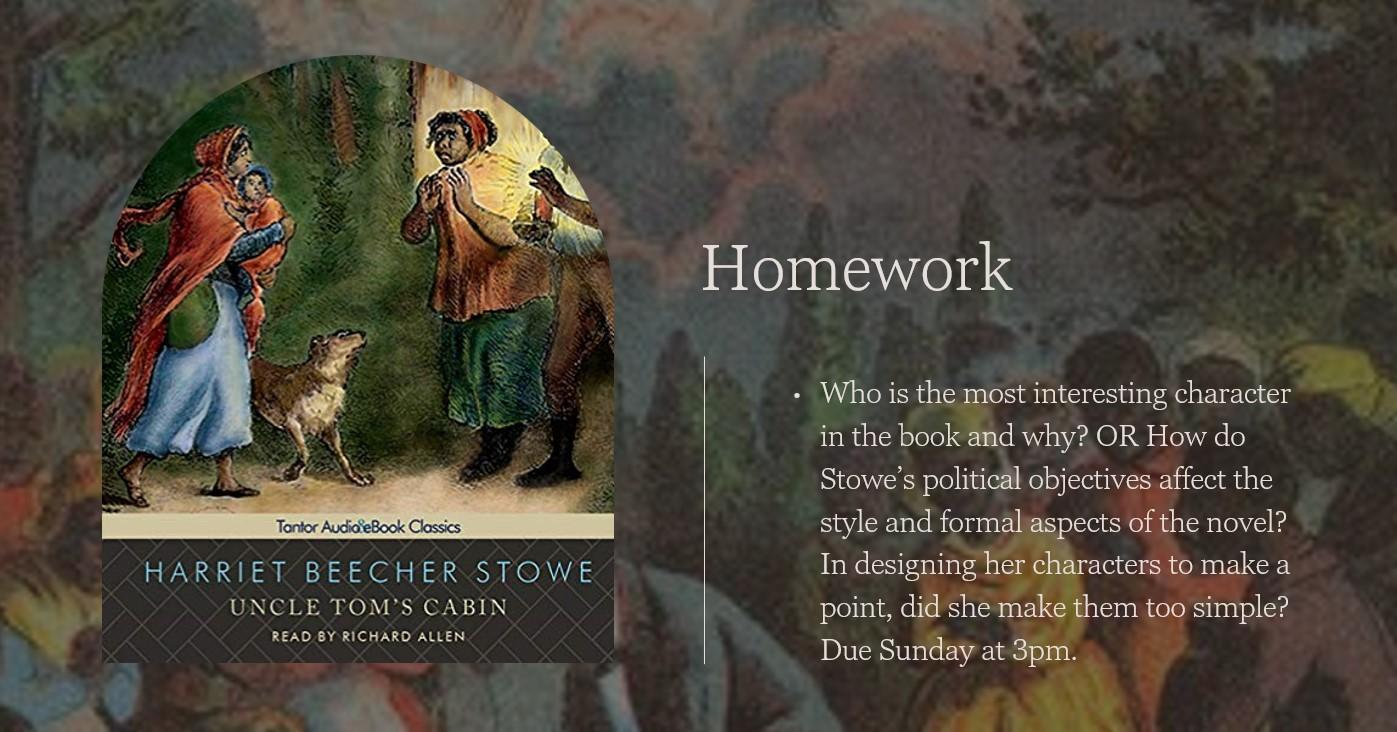
Attachments:
You must be logged in to view attached files. -
at 14:04 #25169
 AmberParticipant
AmberParticipantDear Beth,
Thank you for the historicaly splendiffidous lesson!
—————————————————————————————–
When will they be done? I ask myself as I face the artist with his compatriot easle.
“Fold your arms Harriet,” the spokesman for the painter declares.
I do so, hoping that the outrage in my expression will be rightfully captivated by paint.
“And SMILE.”
I do not. There is no point; all that these artists have been getting from me for six years are grimaces, glowers and glares. I hate these supposed papparazi. They think that they are providing a portrait of me: domestic, conformed aand literary.
Unfortunately for them, I am neither of those.
Already the sweat on the back of my ornamental green dress has started to condense into an air packet, making the skin around my neck itch terribly so.
Impatient; a stamp of the foot; a reprimand.
“Keep still Ms. Stowe,” the spokesman ridgidly acclaims.
I shrug, “Then keep your big mout unopened or I’ll stop posing NOW.”
That seems to do its job. I see the artist glance up, horrified, then start repainting, undoubtedly undoing my ‘un-ladylike’ stamping foot and scowl. On goes in my mind a smillig complexion, a tighter face, a fuller dress, a much more sheek me. I’ll get to that meddling president for this. I fume. Abraham was going to get it. He shouldn’t have ever supposed that painting a free woman would be an easy job.
Attachments:
You must be logged in to view attached files.-
at 17:07 #25237
-
-
at 19:52 #25176
Ethan
ParticipantHello Beth,
I loved your lesson this Tuesday! Please find my homework attached!
Thanks, Ethan
Attachments:
You must be logged in to view attached files.-
at 17:35 #25239
-
-
at 21:36 #25182
Yichen
ParticipantHi Beth,
Here is my homework. The document wouldn’t work.
Who is the most interesting character?
Harry Harris is the most interesting character.
His life represents the ideal life of a slave: he lives with a kind and gentle master and mistress (Mr Shelby and Mrs Shelby, respectively); he successfully escapes to Canada, and lives in freedom with his family for the rest of his life. Harriet Beecher Stowe says that if you are a slave, your life should be this kind of life; Stowe knows that slaves are kind-hearted and talented – they have just been restrained from showing their real potential, just like Harry.
Furthermore, his appearance really reflects his life. His eyes are “full of fire and softness” – depicting his talents and beauty – while his hair “hung in glossy curls” – suggesting his fairly (but not wholly) restricted life.
Finally, the fact that he is essentially impeccable is very interesting, as this highlights how Stowe is trying to present slaves in the best possible light to make them seen too perfect to be slaves. Harry seems unnaturally handsome, astute and moral – almost divine. Stowe is doing this to persuade us that slaves cannot be classed as slaves; that they are almost built to be at a higher standard than white people. The divinity also connects to God, emphasising how God intended all humans to be equal (slavery is a sin as God and the Bible say that we are all equal.) This method of making a character looking divine is particularly effective as most readers at the time would be Christian and would have to agree the slavery is a sin.
Overall, Harry Harris is the most interesting character in my opinion; he is perfect and divine, his appearance reflects his life, the life that Stowe wants every slave to have.
-
at 17:42 #25241
-
-
at 21:37 #25183
Yichen
ParticipantThe document wouldn’t work, so I had to type it out.
Thanks for the magnificent lesson!😉
-
at 13:56 #25202
 :Aryan:Participant
:Aryan:ParticipantDear Beth,
Unfortunately, I couldn’t make this into a word document. Please find my homework below.
Thanks,
Aryan
My Homework:
In my opinion, I think that the most interesting character is Uncle Tom, because he is such a devout Christian, and acts as Jesus against the cruel, brutal Simon Legree. Uncle Tom, a
when raised with Arthur Shelby, was treated well, but Arthur, though being a selfless, heartfelt man, he couldn’t hold back his loans, and had to sell poor Tom. His next owner, St Clare was very drunk and didn’t care about his slaves, but in the St Clare family, which only consisted of St Clare, who was no saint, and Little Eva, thr daughter of St Clare. Eva was kindhearted to Tom, and at her deathbed, she asked all slaves to be set free. But unfortunately, he wish was not fulfilled for Tom. His last and final owner was Simon Legree, the man who decided to kill Tom for not following orders. Legree was ruthless, and even through the threats of Uncle Tom, saying that Legree’ll go to hell, was ignored, and in the end, two other slaves were forced to kill or be killed.
This is why I think Uncle Tom is so interesting, because of his slavehood, the progression of the cruelty of his masters.-
at 12:33 #25280
-
-
at 15:38 #25203
-
at 20:35 #25206
Dudee
ParticipantHi Beth, apologies for very late submission. Homework attached. See you tommorow.
-
at 20:36 #25207
Dudee
ParticipantHi Beth, apologies for very late submission. Homework attached, see you tommorow.
-
at 20:41 #25208
Dudee
ParticipantSorry wrong one i submitted please ignore
-
at 11:38 #25219
Johnny
ParticipantI would think that Uncle Tom is the most interesting character because he is divinely Christian and his beliefs put him in a place of splendour where he had no hope in Legree’s iron grip. His actions and words move and emotionally change even the meanest of characters and I would picture Tom as a hero and as an interesting Christian with miracles that would be impossible to occur in real life.
His determination to end slavery and his relationship with Mas’r George is one of the strongest and his death is at cost of an evil person, a momentous moment for him. It is interesting how he treats and deals with the toughest of his opponents and he is a divine image worth digging into.
-
at 13:05 #25282
-
-
at 16:55 #25236
Yinuo Li
ParticipantDear Beth,
I would think that the most interesting character in ‘uncle tom’s cabin’ is Uncle Tom as he is such a devout Christian, believing it so deeply even against the harsh and brutal treatment against Legree. Additionally, his spirit. and determination is unrivalled in the book, wanting and trying so hard that his death was one of the most impactful deaths in the book, impacting everyone yet at the cost of such an evil Slave owner.
-
at 13:08 #25284
-
-
at 18:15 #25289
Beth
ParticipantSummary for Lesson 3
In today’s class we finished our work on Uncle Tom’s Cabin, thinking about the legacy of the novel and some of the critical opinions on the book in the modern day. We began with thinking about how some of the attitudes in the book may not always align with modern ones on issues such as race and religion, before considering how the presentation of characters such as Topsy can be problematic in hindsight. The class discussed their views on this beautifully, expressing very mature and well thought through ideas in very articulate ways. We then moved on to thinking about the kinds of social issues the students would like to campaign on in the way Beecher Stowe campaigned against slavery and they came up with some wonderfully creative and interesting mediums through which they could spread messages on social issues they are passionate about. As ever, fantastic work from everyone today- I was super impressed by everyone’s ideas. Keep it up class and I’ll see you for Gatsby next week 🙂
Video on Topsy: https://www.youtube.com/watch?v=zKZmtZ63eyE&feature=emb_logo
Video on Uncle Tom: https://www.youtube.com/watch?time_continue=1&v=WYZExxW6fqE&feature=emb_logo
Homework
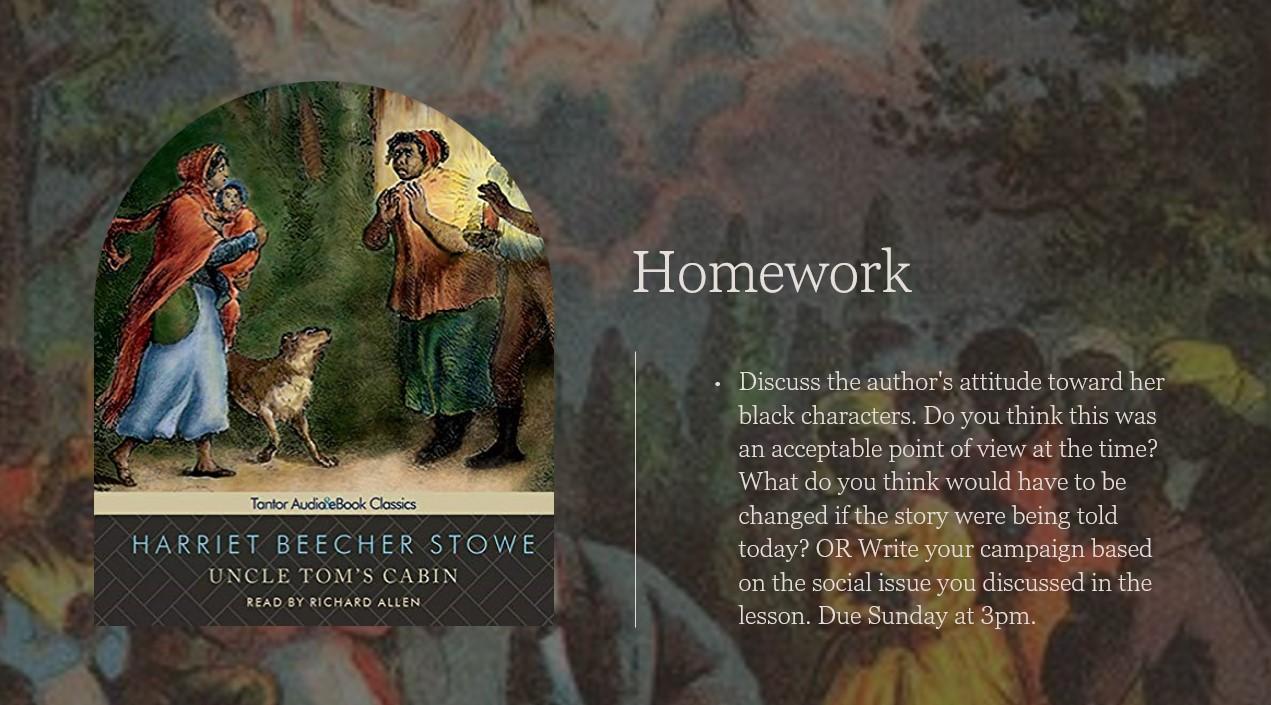
Attachments:
You must be logged in to view attached files. -
at 07:44 #25307
 AmberParticipant
AmberParticipantDear Beth,
Thank you for the specawelastatastic lesson!
————————————————————————————————–
SZEV Z HKOVMWRW IVHG LU BLFI WZB! 🙂 (this code is written in backwards alphabet form)
Attachments:
You must be logged in to view attached files.-
at 15:47 #25371
-
-
at 14:03 #25327
Ethan
ParticipantHello Beth,
Your lesson was wonderful! Please find my homework attached.
Thanks, Ethan!
Attachments:
You must be logged in to view attached files.-
at 15:30 #25369
Beth
ParticipantHi Ethan,
I think you attached the wrong file here- if you get the right one uploaded I can mark it ASAP 🙂 -
at 15:32 #25370
Beth
ParticipantHi again Ethan, sorry completely ignore my last message, I mistook the forum for another one! I’ll get your marking to you very soon 🙂
-
at 15:54 #25373
-
-
at 17:57 #25333
Yichen
ParticipantHi Beth,
Thanks for the magnificent lesson on Uncle Tom’s Cabin.
My homework is attached.
Yichen
Attachments:
You must be logged in to view attached files.-
at 16:04 #25375
-
-
at 21:26 #25383
Yinuo Li
ParticipantHello Beth, thank you for the lesson on this book and I really enjoy them. My homework is attached below.
Climate change is an endless subject talked about in all media, with many conversations, conspiracies and doubts. There are meetings every year to discuss this dire situation and this subject is brought up endlessly in parliament. So what is this problem and how do we solve it.
Climate change first started majorly during the industrial revolution when the use of coal and pollution was heavy throughout the world. This caused carbon dioxide levels to skyrocket, leading to pollution. The main factors of climate change are that greenhouse gasses trap heat and sunlight providing the world to warm up and cause damage and destruction. This provides floods, irregular weather patterns, droughts, wildfires and many plants and animals going extinct.
The ‘United Nations Climate Change Conference’, also known as COP, is an event where several world leaders meet to discuss how climate change should be subdued and stopped. The next COP meeting will take place in Egypt, in November 2022. During COP26, several protests will be held, demanding more action be taken at the conference. as well as having much information.
Many solutions have already been provided, such as using more solar panels, working on nuclear fusion and for the time being, using nuclear reactors (not that I am not providing electric cars as a reason as they require lithium and cobalt which have large impacts on the environment.
In conclusion, climate change is something inevitable, we can not stop it, but we can slow it. In my opinion, we need more of an impact, something which will motivate more people to help in this war for the survival of this earth.
-
at 11:33 #25488
-
-
at 18:13 #25387
Beth
ParticipantSummary for Lesson 4
In today’s lesson we began studying The Great Gatsby by F. Scott Fitzgerald. The powerpoint with all of the resources is attached below, which should be used to help plan and write the paragraphs assigned for homework. The powerpoint contains loads of information on the context of The Great Gatsby, considering the crucial contextual ideas of the Roaring 20s in America and the American Dream. It also contains our thoughts on the key themes and motifs within the novel, and our discussion on how the novel deals with the concepts of wealth inequality and social class. Everyone worked wonderfully today, we had a great discussion about our favourite and least favourite things about the book, in which students successful picked out the most interesting and enlightening features of the novel. The students were very engaged throughout and contributed a range of really fascinating and well-informed opinions on the history and why it matters in the novel. Lovely work as ever class, well done and see you next week 🙂
Context in Gatsby video: https://www.youtube.com/watch?v=1XM30FUke5U
Homework
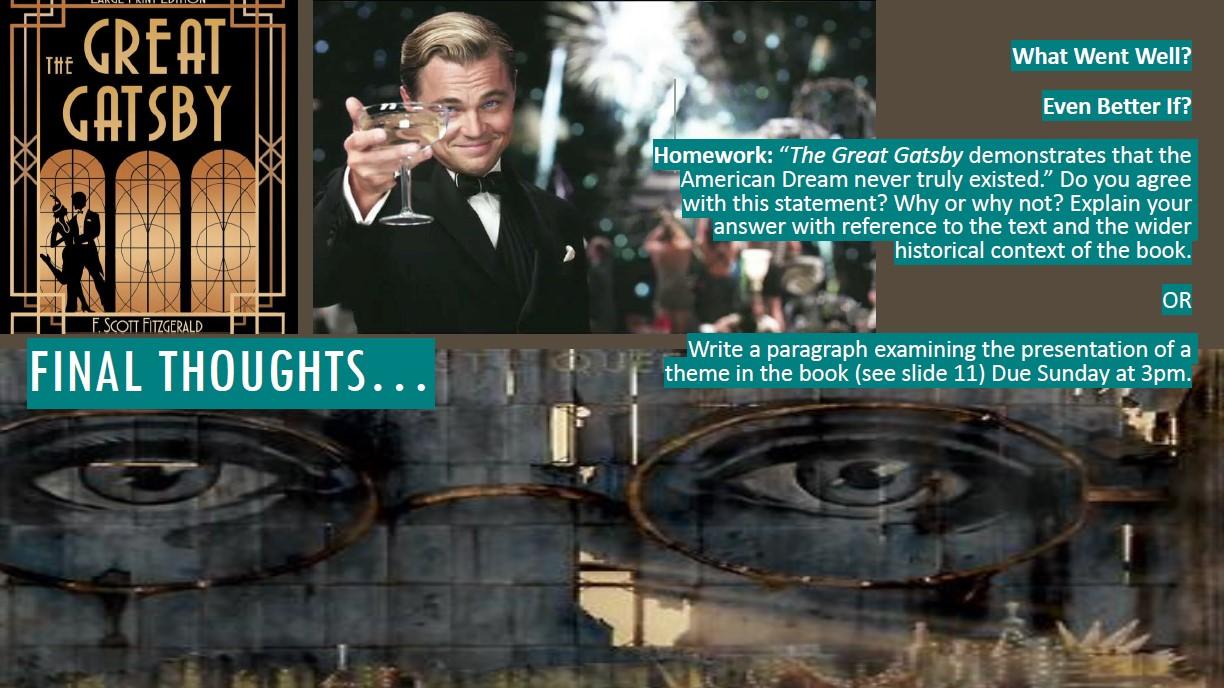
Attachments:
You must be logged in to view attached files. -
at 11:25 #25402
 AmberParticipant
AmberParticipantDear Beth,
Thank you for such glamourous and whizz lesson! 🙂
———————————————————————————————————
^Above: Image of 1920s man and woman
Attachments:
You must be logged in to view attached files.-
at 11:44 #25490
-
-
at 11:27 #25404
 AmberParticipant
AmberParticipant^1920s Car design
-
at 11:29 #25405
 AmberParticipant
AmberParticipant^The 1920s also saw a rise in technologies such as the telephone
-
at 11:31 #25406
 AmberParticipant
AmberParticipant^1920s Jazz Age
-
at 11:32 #25407
 AmberParticipant
AmberParticipant^1920s Suffrage
-
at 12:27 #25427
Ethan
ParticipantHello Beth,
I thought your lesson was wonderful! Please find my homework attached.
Thanks, Ethan
Attachments:
You must be logged in to view attached files.-
at 11:50 #25492
-
-
at 14:40 #25439
Yichen
ParticipantHi Beth,
Thanks for the spectacular lesson! Here’s my homework:
The theme of desire is explored through Mr Gatsby. The quote “he stretched out his arms towards the dark water” but all that the narrator could see was “green light,” depicts that he craves for the “green light” (hope); however, the water and light are far from his reach, highlighting the fact that his desire will never be fulfilled.
-
at 11:54 #25494
-
-
at 18:09 #25476
Yinuo Li
ParticipantDear beth, here is my homework for this week.
Attachments:
You must be logged in to view attached files.-
at 12:00 #25496
-
-
at 19:13 #25505
Beth
ParticipantSummary for Lesson 5
In today’s lesson we continued studying The Great Gatsby by F. Scott Fitzgerald. The powerpoint with all of the resources is attached below, which should be used to help plan and write the paragraphs assigned for homework. The powerpoint contains all our thoughts on the style and narrative of the novel, focusing particularly on the role of symbolism and the genre of tragedy and how this relates to the book. It contains thoughts on character analysis, the theory of Nick as the unreliable narrator and the students’ analysis of tragic elements within the book which they completed fantastically. We had a really great discussion on the concept of time within the book, analysing the symbolic importance of the scene where Gatsby and Daisy see each other again for the first time. The students also shared some interesting ideas on whether the characters in the novel are well-rounded or more two-dimensional and how they represent different themes within the story. I really enjoyed hearing everyone’s opinion on Gatsby’s status as a tragic hero and his hamartia, or ‘tragic flaw’, and thought that the way they conceived of Nick’s narration and its trustworthiness was brilliant. Really fantastic ideas and work today everyone- keep it up ! 🙂
Tragedy video: https://www.youtube.com/watch?v=eVRU5MVYNiw
Homework
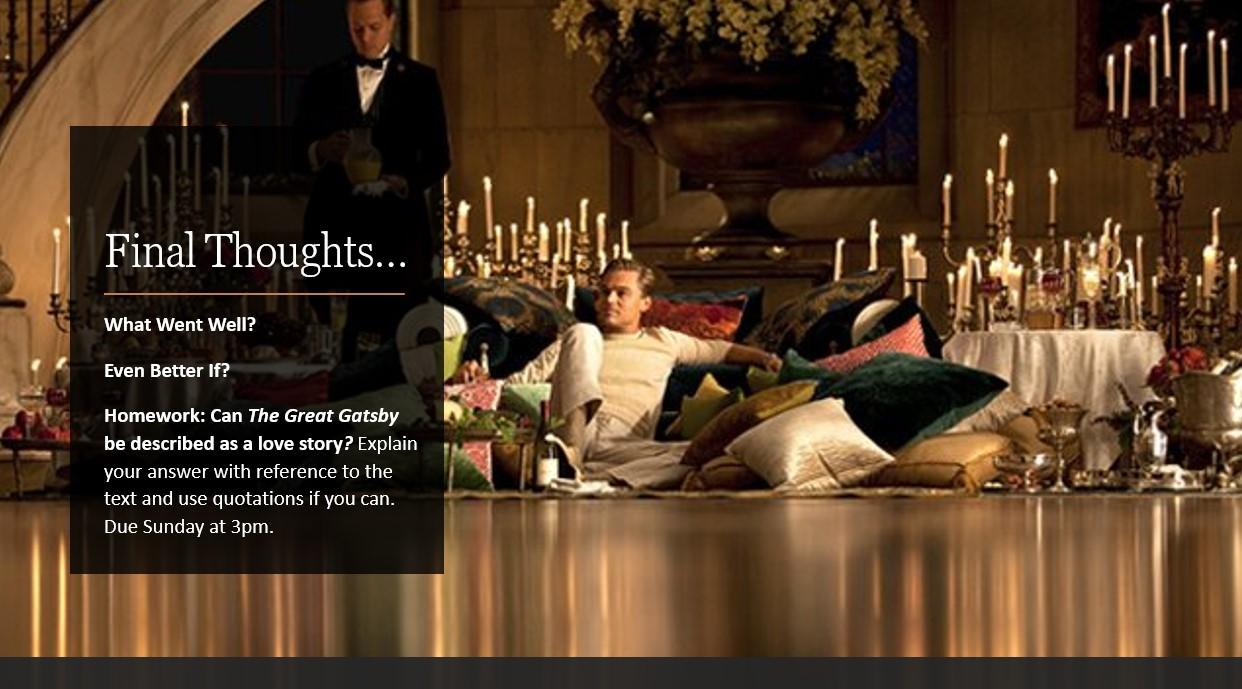
Attachments:
You must be logged in to view attached files. -
at 12:26 #25519
 AmberParticipant
AmberParticipantDear Beth,
Thank you for such a fab-licious lesson! 😉 (>o<*)
—————————————————————————————————————————–
The crusty warm bread was just fresh from the oven, crisp and sensual with a smooth sense of delicacy shrouding the doughnut bread. Coating this succulent jacket came particoloured sprinkles, lively, vibrant, almost faerie-like. Greens, yellows, magentas, cyans… And the aroma! Sweet, almost too sweet, with an extra coating of bitter mint, for that was the stuffing. In neat rows; in small packets; on plated of silver shape, these spirited pieces of artisan bread circulated the market that day, fermenting the rich air with an even richer perfume.
As far as Tiberglenn the smell spread, welcoming glances of appraisal everywhere it set foot. This was early Sweetestival.
Attachments:
You must be logged in to view attached files.-
at 22:28 #25598
-
-
at 13:44 #25549
Ethan
ParticipantHello Beth,
Here is my homework for this week!
Thanks for the lesson,
Ethan
Attachments:
You must be logged in to view attached files.-
at 22:34 #25600
-
-
at 11:07 #25557
Johnny
ParticipantI would think that the Great Gatsby is a love story. It is filled with trauma and sadness as Gatsby tries his best to attract Daisy, only letting Tom take Daisy.
It is like a love story and also like a Greek tragedy. It is similar in style to Shakespeare’s Romeo and Juliet, except losing Daisy to Tom, not Romeo to Death. Gatsby’s mistake is what leads to his downfall in his love for Daisy. Like other love stories, Gatsby is attached and related to Daisy in one way, but also like other stories, his method of trying to hand Daisy over to him fails and he suffers to see Daisy going with Tom, making it a love story (a very sad one).
-
at 22:46 #25602
-
-
at 11:11 #25564
 :Aryan:Participant
:Aryan:ParticipantDear Beth,
Thanks for the lesson (((o(*゚▽゚*)o)))! Please find my homework attached.
Thanks,
Aryan
Attachments:
You must be logged in to view attached files.-
at 22:52 #25604
-
-
at 09:42 #25606
-
at 18:06 #25612
Beth
ParticipantSummary for Lesson 6
In today’s lesson we concluded our study of The Great Gatsby by F. Scott Fitzgerald. The powerpoint below contains our work on the close textual analysis of The Great Gatsby, focusing in particular on elements such as the importance of symbolism in the novel, the symbolic importance of the deaths of both Gatsby and Myrtle, the ideas of class and consequence prevalent in the novel, and Fitzgerald’s final reflection on the validity of the American Dream. The students all worked fantastically hard today, we had some really insightful, interesting and imaginative contributions from everyone on the three symbols we studied closely this lesson: the green light, the eyes of Dr Eckleburg and Myrtle’s death. I was super impressed by the creativity and thoughtfulness the class demonstrated in discussing these themes, and also really enjoyed hearing their 1920s newspaper reports that reflected the prejudices of the time. Fab and interesting work from everyone today- they all shared some really insightful and fascinating contributions. Well done class, keep up the great work 🙂
Homework
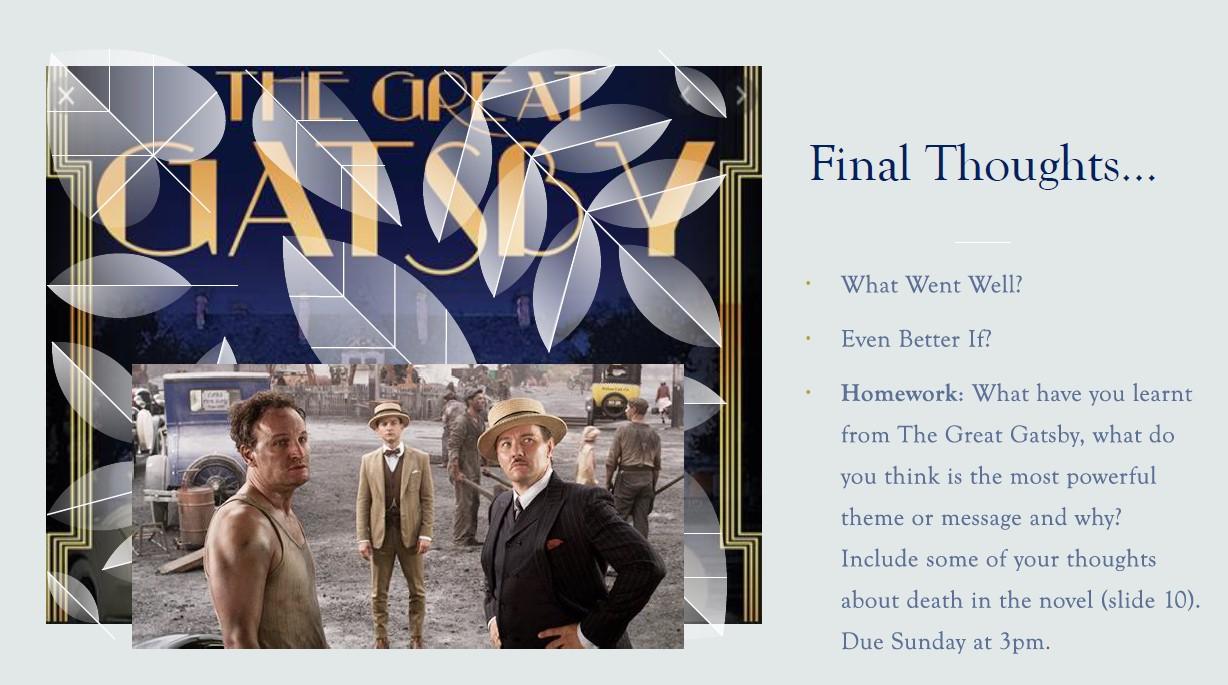
Attachments:
You must be logged in to view attached files. -
at 08:40 #25652
 AmberParticipant
AmberParticipantDear Beth,
Thank you for such a moving and thought-provoking leson!——————————————————–
Fun Fact!
J.D. Salinger made it clear that he wouldn’t allow a film version of The Catcher in the Rye to be produced-so no screenplay version of his novel exsists.
Attachments:
You must be logged in to view attached files.-
at 12:58 #25699
-
-
at 16:29 #25659
Ethan
ParticipantHello Beth,
I enjoyed your lesson today!
Thanks, Ethan
Attachments:
You must be logged in to view attached files.-
at 13:18 #25701
-
-
at 18:10 #25663
 :Aryan:Participant
:Aryan:ParticipantDear Beth,
Thanks for the class o(〃^▽^〃)o! Please find my homework attached.
Thanks,
Aryan
Attachments:
You must be logged in to view attached files.-
at 13:37 #25703
-
-
at 08:33 #25693
Yichen
ParticipantHi Beth,
Thanks for the wonderful lesson – I really enjoyed it!😀 Here is my homework, which is quite late.
Yichen
Attachments:
You must be logged in to view attached files.-
at 13:54 #25705
-
-
at 18:14 #25712
Beth
ParticipantSummary for Lesson 7
In today’s lesson we began our third book, The Hunchback of Notre Dame by Victor Hugo, learning about the historical context and ideas that the book reveals about the time of its publication. We began by discussing our likes and dislikes within the book before talking about the historical context of both the late 1400s (when the book is set) and the early 1800s (when the book was written). We learnt about France’s gothic past, thought about how understanding Hugo as an author could help inform our understanding of the novel, and spoke about the background of the 1789 French Revolution. Finally we spoke about stereotypes and where these appear in the novel, thinking in depth about how Hugo subverts and conforms to particular ideas of his time. Excellent work from everyone today- I really enjoyed hearing their research on the period and thought their understanding of the history was great. Well done class 🙂
Homework
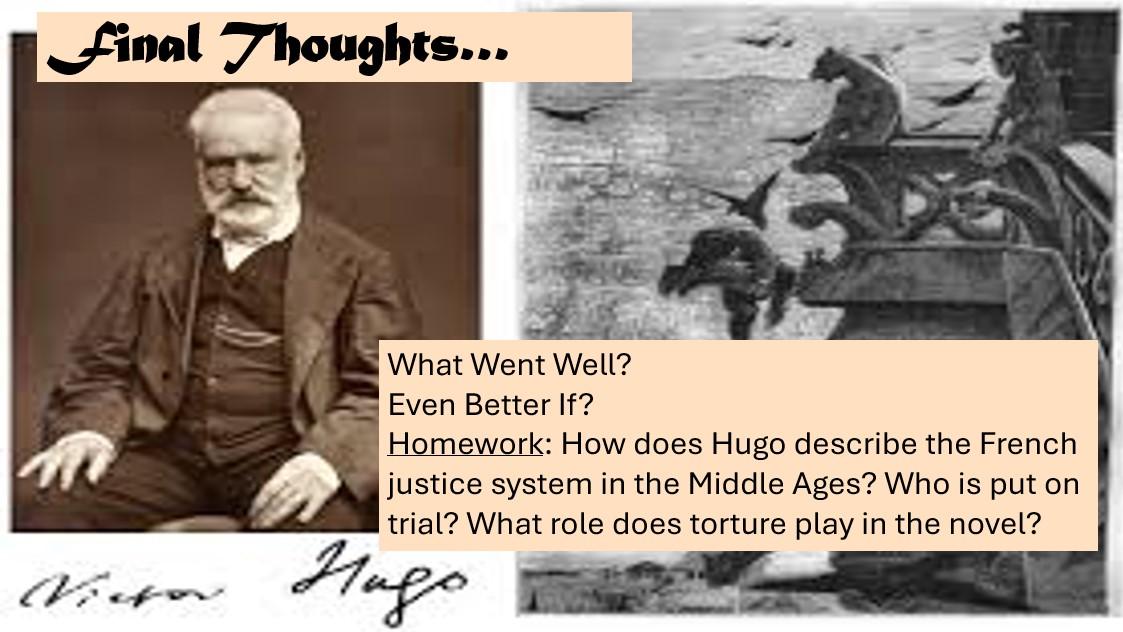
Attachments:
You must be logged in to view attached files. -
at 10:35 #25743
 AmberParticipant
AmberParticipantDear Beth,
Thank you for a whizzastic lesson! 😉
———————————–
The Quiet
It was quiet at the docks, silent and shifting and smoky. Ogla saw only one house, one plume of smoke and one rikety wooden platform. It was not a dock. It was a replacement. The fire had smote most of the grand poles to ash and there still lingered a small strain of black on the beach edge. But fire reigned. The sky embraced earth with shattering, glistening shards of fire that curved in a strange majesty around the single log cabin.
Attachments:
You must be logged in to view attached files.-
at 12:33 #25812
-
-
at 18:40 #25765
 :Aryan:Participant
:Aryan:ParticipantDear Beth,
Thanks for the lesson o(*////▽////*)q! Please find my homework below.
Thanks,
Aryan
In the Hunchback of Nôtre-Dame, Quasimodo is paraded around the streets of Paris as the ugliest man that year. This is mind torture as Quasimodo will become depressed as he is the ugliest man.
Also, La Esmeralda, a gypsy-woman was put on trial for helping Frodo and Quasimodo. Then, after being proven guilty, she was tortured and sentenced to death. But fortunately for her, she was rescued by Quasimodo.
But in terms of love, La Esmeralda falls in love with a man called Phoebus and Frodo is in romantic torture: Frodo likes La Esmeralda.
Also, in the way of stereotypical torture, the book starts off with an admiration of the Romani people because of La Esmeralda, but then at the end, we realise La Esmeralda was in fact French-born, but adopted by Romani parents.
-
at 12:40 #25814
-
-
at 10:57 #25771
Ethan
ParticipantHello Beth,
Thanks for the excellent lesson! Please find my homework attached.
Thanks, Ethan
Attachments:
You must be logged in to view attached files.-
at 12:54 #25816
-
-
at 16:53 #25789
Yichen
ParticipantHi Beth,
Thanks for the lesson; I really enjoyed it!❤ Here is my homework.
Yichen
Attachments:
You must be logged in to view attached files.-
at 13:04 #25818
-
-
at 16:54 #25791
-
at 20:58 #25807
Yinuo Li
ParticipantDear Beth, here is my homework, (P.S sorry I couldn’t make the lesson)
Hugo describes the French justice system as unfair and corrupt, holding no truth and lying to the citizens. For example, Esmeralda and Quasimodo, are imprisoned for crimes they did not commit. It is a life of Terror, and secrecy, not knowing if you’re going to die the next day. On the other hand, the real criminals are not imprisoned, for example, Claude Frollo who stabbed and killed Phoebus.
Also, torture and terror play a huge role in the book, emphasising the threat and the power of the supposed ‘government’ of the country. Many are oppressed and executed for things that they did not do. Hugo depicts the torture as a method for many to fall in line, which emphasises just how far they go to make the peasants their slaves.
-
at 13:09 #25821
-
-
at 14:32 #25826
Dudee
ParticipantThanks for the lesson, here is my homework(apologies for its lateness.
Hugo through his writing tell us that the French justice system is corrupt and unreliable, an example is shown when Quasimodo is put on trial after attempting to kidnap a woman on someones orders. Quasimodo is “ugly” and is deaf, and on trial the judge assumes what he is saying as Quasimodo cannot interpret what the judge is saying, as he is deaf. The judge sentences him to a flogging by the crowd, even though he has not heard a shred of evidence of even tried to interpret Quasimodo. This shows the the outcome of the trial decides in the judge, and it is clear to say that the judge in cases like these wants to get it over and done with, quickly.
In the book, a Roma girl,16 years old called Esmeralda is a street dancer, she is later accused of murdering someone, who was framed for the murder, is accused of murder and witchcraft.
Torture is a very common feature during Middle Age France, using it to gain confessions(which were unreliable and manipulated to get the confessions the judge wanted). Torture is used for minor offences in Middle Age France.
Hugo tells us that the French justice system is brutal, cruel and lack of clear sense. Witchcraft was a crime back then, and (mostly) women were persecuted and executed for being near things associated with bad luck, and tales told by neighbours. Judges decided the decision, not from evidence but from their own assumptions and opinion. This was shown in Quasimodo’s trial. In the Middle Ages, Victor Hugo shows that you could not trust the Justice system.
-
at 08:31 #25973
-
-
at 17:57 #25854
Beth
ParticipantSummary for Lesson 8
In today’s class we continued our work on The Hunchback of Notre Dame, thinking today in depth about narrative within the novel and how that can reflect societal norms and opinions of the time. We began by discussing the perspective the story is told from, thinking about the notion of the unreliable or biased narrator and how to separate this concept from that of author’s voice. The class then analysed examples from the book where the narrator appears opinionated or non-neutral with regards to the events- and the students then created their own narrator characters to match these ideas. Finally we looked in depth at an article about the book written by a Roma author considering the way both Roma people and women are presented by this narrator and how this can be read alongside theories about race and gender stereotypes in the book. Great work from everyone today and some particularly astute contributions on the role of narrative in the novel. Fantastic job everyone, especially in comprehending some big academic concepts. Keep up the amazing work! 🙂
Homework
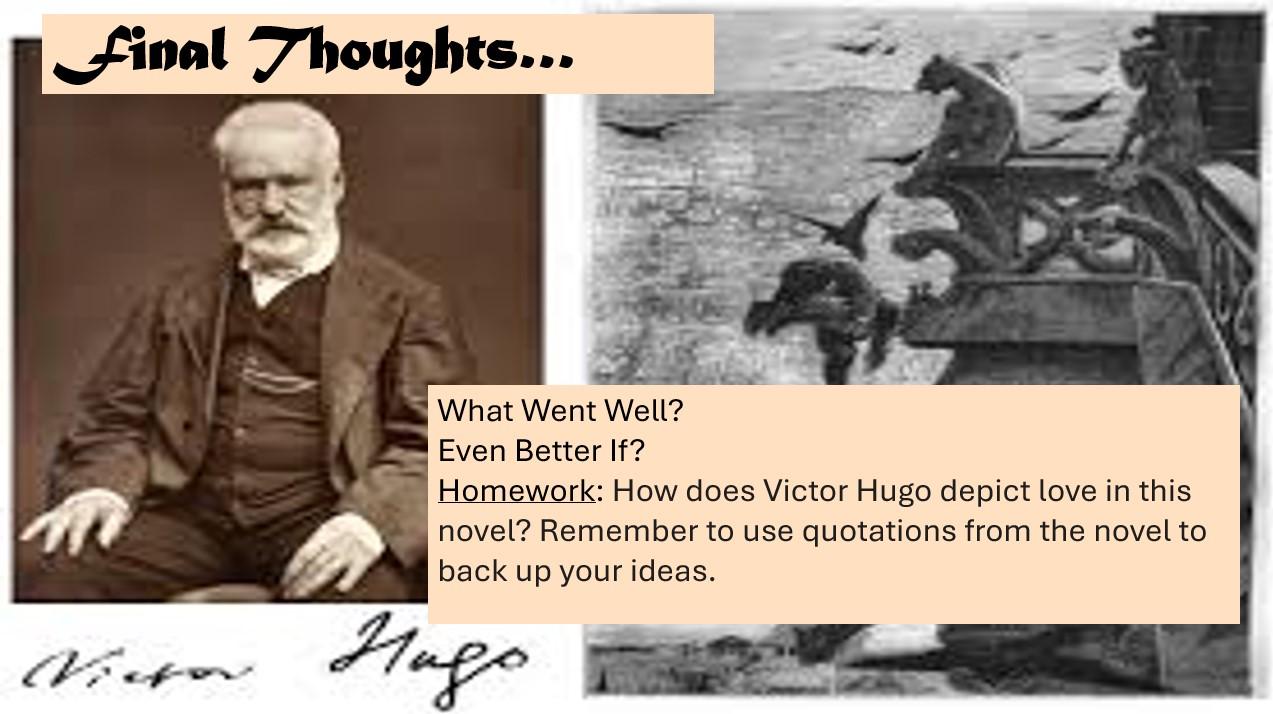
Attachments:
You must be logged in to view attached files. -
at 05:52 #25860
 AmberParticipant
AmberParticipantDear Beth,
Thank you for such a splendidly contextual lesson!
——————————-
Attachments:
You must be logged in to view attached files.-
at 08:43 #25975
-
-
at 05:54 #25862
 AmberParticipant
AmberParticipantla Esmeralda
Jewelo f fair Paris
doth blemished an eye
set behind gargoyle
clad nift in pyre
sought by many
and perished on nift
the threshold
of Notre Dame
-
at 05:55 #25863
 AmberParticipant
AmberParticipant -
at 11:08 #25879
Yichen
ParticipantHi Beth,
Thanks for the wonderful lesson! Here is my homework.
Attachments:
You must be logged in to view attached files.-
at 12:14 #25978
-
-
at 11:55 #25902
Ethan
ParticipantHello Beth,
Thanks for the lesson!
In Notre Dame, Victor Hugo depicts love as being powerful and illogical. Notre Dame is a French Gothic novel. Not a lot of the love presented in this book is ‘normal – a man and a woman’ or familial. Frollo’s growing love for Esmeralda causes him to abuse his power and get her kidnapped. Additionally, Esmeralda’s love for Pheobus makes her forget her two good men: including her own husband.
-
at 12:18 #25980
-
-
at 22:09 #25918
Dudee
ParticipantThanks for the great lesson, apologies for not being there, I have not read the book so unable to find quotations. Apologies for abrupt cutoff. See you on Tuesday.
Beth’s Summer Reading Homework
Love in Victor Hugo’s book, The Hunchback of Notre Dame, is represented fully and in extraordinary detail.
A man who is deemed “ugly” and has a disability falls in love with a beautiful Roma girl after she gives him water when enduring a beating, when nobody else helped him. However, two men who are affluent( I think) both love the Roma girl. One of the lovers of the Roma girl later kills the other one, framing it on the Roma girl out of jealousy. The Roma girl is put on trial, (Esmeralda) and is accused of attempted murder and is accused of witchcraft and is put to death. Quasimodo(the man deemed “ugly” who is in love with Esmeralda) watches in horror as Esmeralda is hanged. Quasimodod kills the man who framed Esmeralda,( Frollo,the Archdeacon) by pushing him off the Cathedral to his death below. A few years after, Quasimodo is found laying beside Esmeralda in a Mass Grave, when the guards pull his skeleton away from Esmeralda, his skeleton crumbles to dust.
Victor Hugo makes it evident in this book that everybody has the ability to love, even when stereotypes were common and vocal when this book was set;(France in the Middle Ages), with people different from the majority, and help people, or do a despicable act. Giving a drink of water to a man asking for it, and framing a murder, the former and latter respectively. Love is shown in this book like a seesaw, one person loving the other, then the other person loving another person, then it turns into a display of deep affection for one person after a tragic accident. I feel that this book is a classic, myriad of meanings, and love is a very central , powerful and driving force in this book.
-
at 12:27 #25982
-
-
at 13:19 #25926
 :Aryan:Participant
:Aryan:ParticipantDear Beth,
Thanks for the amazing class ψ(`∇´)ψ! Please find my homework attached.
Thanks,
Aryan
Attachments:
You must be logged in to view attached files.-
at 12:36 #25984
-
-
at 21:07 #25963
Yinuo Li
ParticipantDear Beth,
Here is my homework and thank you for the fantastic lesson.
Attachments:
You must be logged in to view attached files.-
at 12:45 #25986
-
-
at 17:55 #25988
Beth
ParticipantSummary for Lesson 9
In today’s class we finished our work on The Hunchback of Notre Dame, considering some core concepts of the novel such as the role of protagonist/ antagonist divides and the concept of free-will. We began by speaking about Frollo and whether we could consider him a typical villain, using an essay to expand our ideas. We then spoke about the philosophical concept of free-will and predetermination, linking ideas on this to the characters and plot of the novel and answering some comprehension style questions on these themes. Finally the class completed some creative work on setting, thinking about the centering of Notre Dame in Hugo’s novel, and considered some final debate questions to conclude our work on this book. Fantastic work from everyone today- I really enjoyed hearing their brilliant ideas particularly on the topic of free-will and how society’s definition of it has changed over time. Really well done class, you all worked superbly today and it was wonderful to hear all your thoughts. See you next week! 🙂
Free-will video: https://www.youtube.com/watch?v=HYWiIWpcCIM
Homework
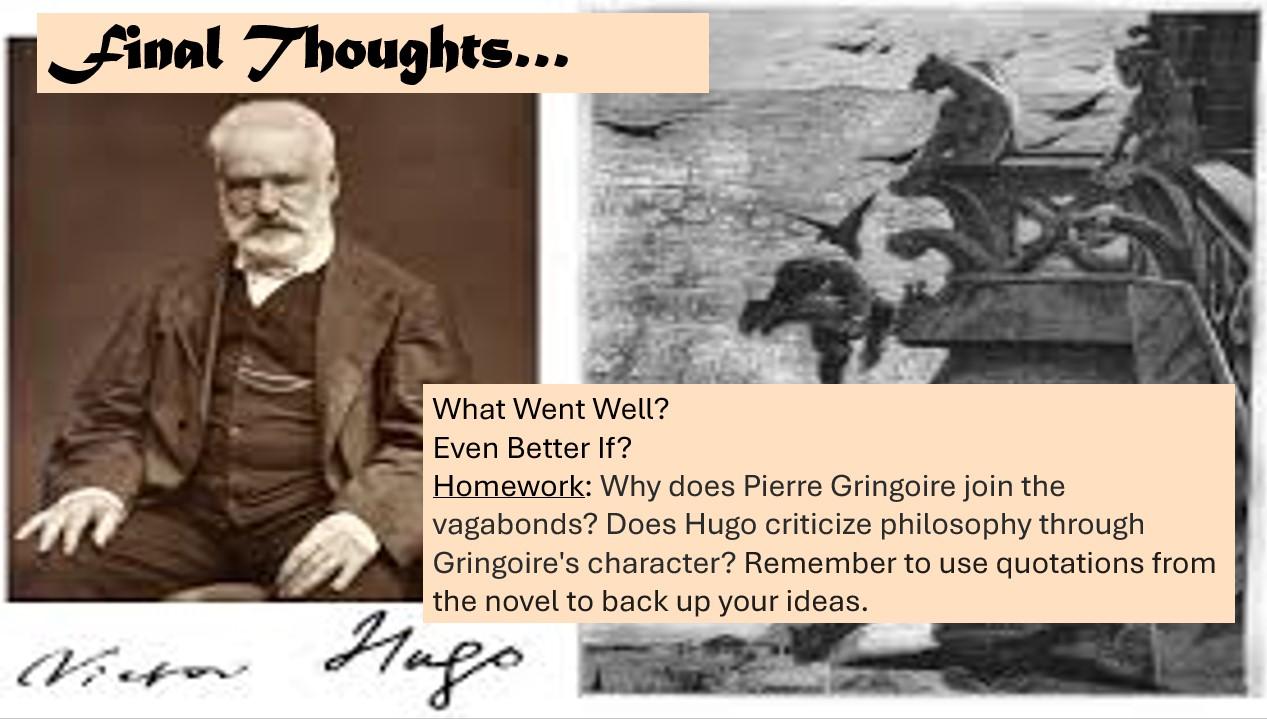
Attachments:
You must be logged in to view attached files. -
at 18:08 #26009
 :Aryan:Participant
:Aryan:ParticipantDear Beth,
Thanks for the class ヾ(^▽^*)))! Please find my homework attached.
Thanks,
Aryan
Attachments:
You must be logged in to view attached files.-
at 22:18 #26069
-
-
at 12:22 #26013
 AmberParticipant
AmberParticipantDear Beth,
Thanks as always for the bloom-ificent lesson- 🙂
————————————–
The Fat Cat
The cat who ran sour
made an attempt to dance an hour
and batted all the furniture a mile
La Esmeralda
was cross at him
for making her dance
so un-worthwhile
Attachments:
You must be logged in to view attached files.-
at 22:32 #26071
-
-
at 12:35 #26015
 AmberParticipant
AmberParticipantAalysis of Gargoyles in The Hunchback of Notre Dame
The gargoyles in the Hunchback are simply mechanisms for pouring lava through-as well as artifacts/ symbols of both the beauty and ugliness. For a fact, they may well reflect Quasimodo’s outer ugly shell and his inner beauty- one which is tragically overlooked by la Esmeralda.
-
at 12:37 #26016
 AmberParticipant
AmberParticipantGargoyle Spewing Green
Oh great Slab
How green the summer light makes you seem
And once the dawn light comes
The great mouth of Notre Dame
Will spill Green in the spotlight
-
at 12:49 #26026
Ethan
ParticipantHello Beth,
Thanks for the lesson, find my homework attached.
Thanks, Ethan
Attachments:
You must be logged in to view attached files.-
at 12:20 #26080
-
-
at 13:07 #26028
Dudee
ParticipantGood afternoon Beth,
I have attached my homework below, thank you for the finishing lesson on The Hunchback of Notre-Dame. Sorry for no quotations. Have a good day Beth!
Attachments:
You must be logged in to view attached files.-
at 12:36 #26082
-
-
at 10:41 #26034
Yichen
ParticipantHi Beth,
I just want to point out that I think you spelt Esmeralda wrong – you wrote Esmerelda but it is Esmeralda.
Thanks for the lessons on Hunchback of Notre Dame!😀At first, I didn’t like this book much, but now you have clarified it so much and I really enjoy this book now!💖
Yichen
Attachments:
You must be logged in to view attached files.-
at 12:48 #26084
-
-
at 15:04 #26090
Yinuo Li
ParticipantDear Beth,
Here is my homework and sorry it is late and I missed the lesson again.
Thank you.
Attachments:
You must be logged in to view attached files.-
at 13:53 #26194
-
-
at 18:14 #26094
Beth
ParticipantSummary for Lesson 10
In today’s lesson we began our final book Northanger Abbey by Jane Austen. We began the class in a slightly more unusual way than normal, exploring the boundaries between reality and fiction and what each student thought the relationship between the two could be described as, using a creative writing task to help them map this out. We then spoke about how this relates to the novel and discussed our likes and dislikes within the book. Moving on we thought about the historical context of the 18th century, focusing on the ways in which Austen uses irony to satirise the gothic and why she might have done this, with a final fantastic conversation about the role of gothic literature in the book and how we understand the conventions of this genre. Fantastic work on a tricky subject today everyone- you all contributed beautifully and worked really thoroughly. Lovely ideas as always and really creative responses to the questions. Keep up the great work! 🙂
The Mysteries of Udolpho video we watched: https://www.youtube.com/watch?v=4TDr0CYNaak
The irony video we watched: https://www.youtube.com/watch?v=q6e0oNVx8Uk&t=2s
Homework
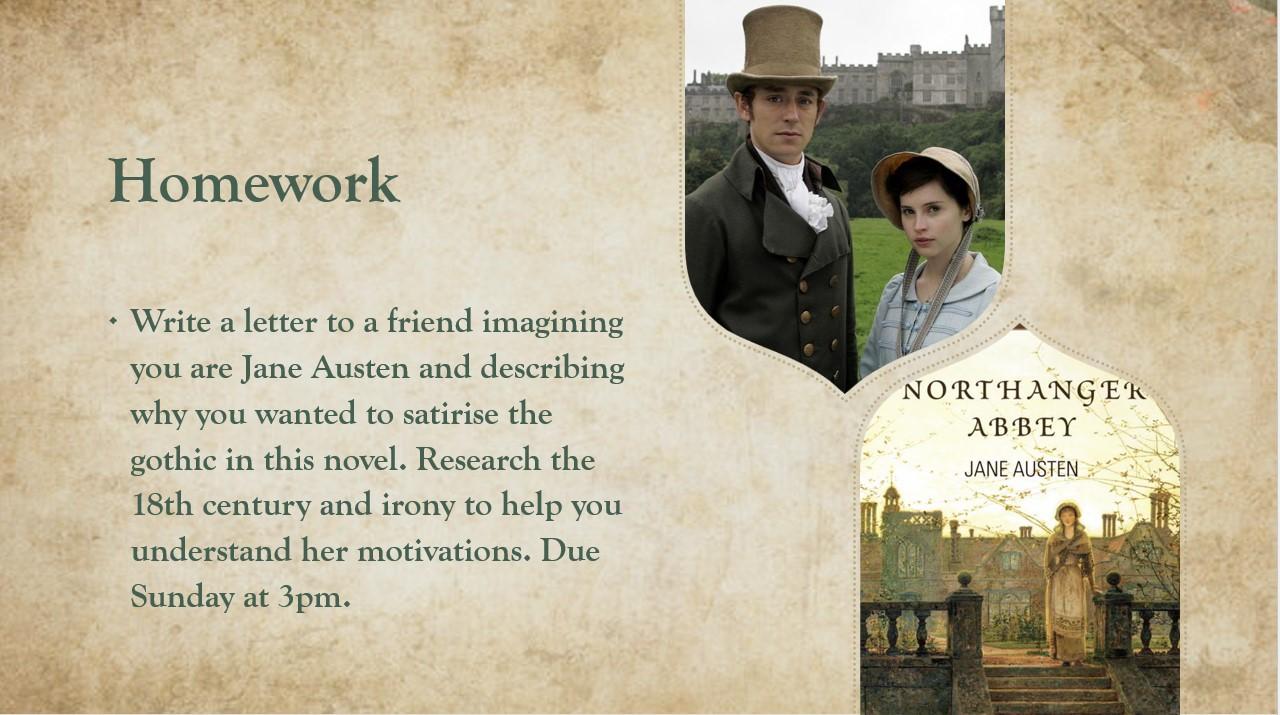
Attachments:
You must be logged in to view attached files. -
at 15:01 #26109
 AmberParticipant
AmberParticipantDear Beth,
Thank you for the extrordinarily creepy lesson (oh, and I didn’t have those nightmares I mentioned- I may have drunk too much milk to dream at all 😉 ) !
…………………………………………………………….
Riddle me diddle me
Tiddle me liddle me
What is that oaken tree
which scrapes jus by
and hears the sighs
of a million green pairs?
What the gothic frame?
And where the normael?
Answer: The theme of EXPECTATION in Northanger Abbey
Attachments:
You must be logged in to view attached files.-
at 14:19 #26196
-
-
at 15:01 #26111
 AmberParticipant
AmberParticipant -
at 22:18 #26119
Yichen
ParticipantHi Beth,
Thanks for the first-class lesson!❤I really enjoyed the gothic bit particularly.😊
Here is my homework.
Yichen
Attachments:
You must be logged in to view attached files.-
at 14:30 #26198
-
-
at 14:08 #26141
 :Aryan:Participant
:Aryan:ParticipantDear Beth,
Thanks for the class (*Φ皿Φ*)! Please find my homework attached.
Thanks,
AryanAttachments:
You must be logged in to view attached files.-
at 16:21 #26200
-
-
at 18:03 #26144
Ethan
ParticipantHey Beth,
Sorry I haven’t uploaded my homework. I had a event at school over the weekend, and I’ve been really busy!
Thanks, Ethan
-
at 19:42 #26206
Beth
ParticipantSummary for Lesson 11
In today’s class we continued our study of Northanger Abbey digging into the ideas and themes in the novel. We began by thinking about Austen’s defence of the novel and the literary context of Romanticism reading a passage from the novel where Austen lays out her ideas on the mockery of novels as a form of art. We then watched a clip from the film, analysing the way society is presented within it and thinking about what it can tell us about class, etiquette and gender in the period. We spoke about gender roles and discussed whether Austen was supporting or undercutting women in her presentation of Catherine in the book, analysing different quotations to support our findings. The class worked fantastically today, contributing brilliant and well-informed ideas and engaging with all different kinds of debates and theories. Amazing job everyone- keep up the hard work and I’ll see you next week for our final lesson of the course! 🙂
Homework
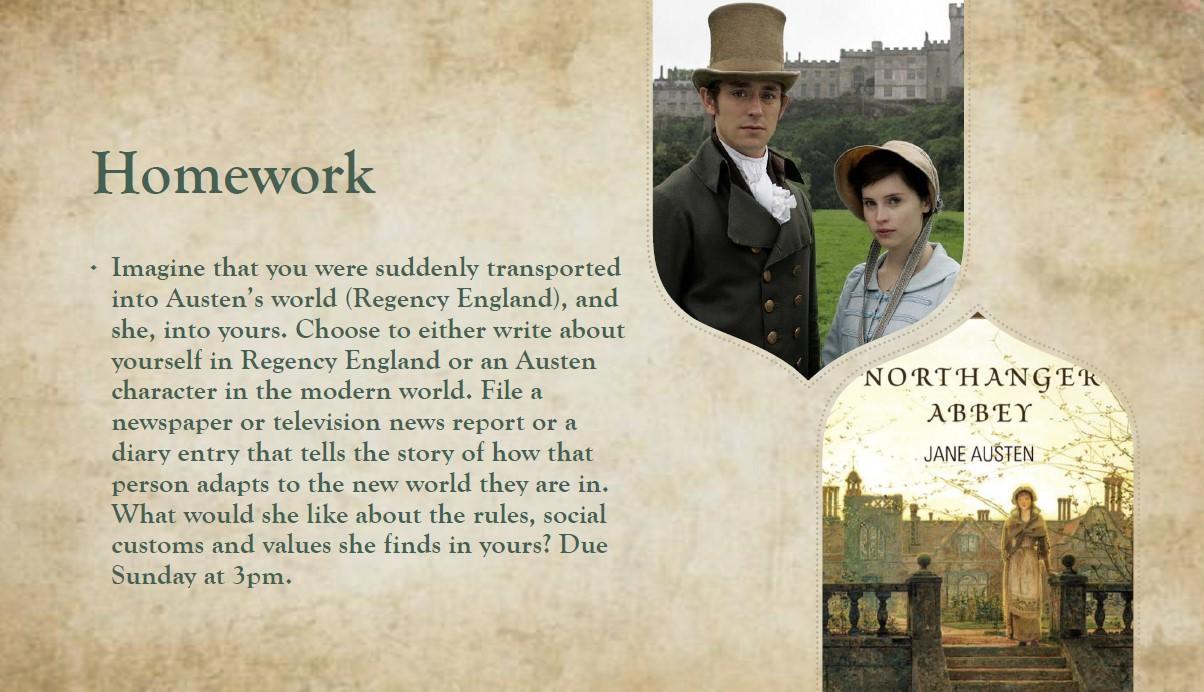
Attachments:
You must be logged in to view attached files. -
at 15:15 #26211
 AmberParticipant
AmberParticipantDear Beth,
Thanks as always for the flor-ificent lesson ❀ 😉
P.S. I wrote from the perspective of Emma, from Emma by Jane Austen in the homework :>
————————————————————————————————————
Attachments:
You must be logged in to view attached files.-
at 10:48 #26242
-
-
at 14:16 #26233
 :Aryan:Participant
:Aryan:ParticipantDear Beth,
Thanks for the class o(*°▽°*)o! Please find my homework attached.
Thanks,
AryanAttachments:
You must be logged in to view attached files.-
at 10:55 #26244
-
-
at 14:59 #26235
Yichen
ParticipantHi Beth,
Thanks for the lesson! 😊 Here is my homework
Yichen
Attachments:
You must be logged in to view attached files.-
at 15:45 #26246
-
-
at 18:07 #26250
Beth
ParticipantSummary for Lesson 12
In today’s class we finished our work on Northanger Abbey, concluding our series of lessons with a class full of debate questions and analysis of the concept of pop culture and satire. We began by thinking about a Jane Austen survival guide, pulling out the rigid and immovable social structrues of the Regency Age, before moving on to thinking about the notion of corruption of the mind that the novel deals with. We spoke about satire and culture, connecting these ideas to the modern world, and the class used these ideas to complete some fantastic creative interpretations of inter-generational concerns over modern society. We spoke about the themes in the book, thinking about the notion of the criminal heart and what it reveals about Austen’s aims, and finally considered what our focus on the morbid tells us about humanity. Lovely work from everyone as always- I was so impressed by all your thoughts and discussions today and over the past twelve weeks. Really fantastic, creative and compelling ideas from all of you- well done class and I will see you in the autumn term! 🙂
Homework
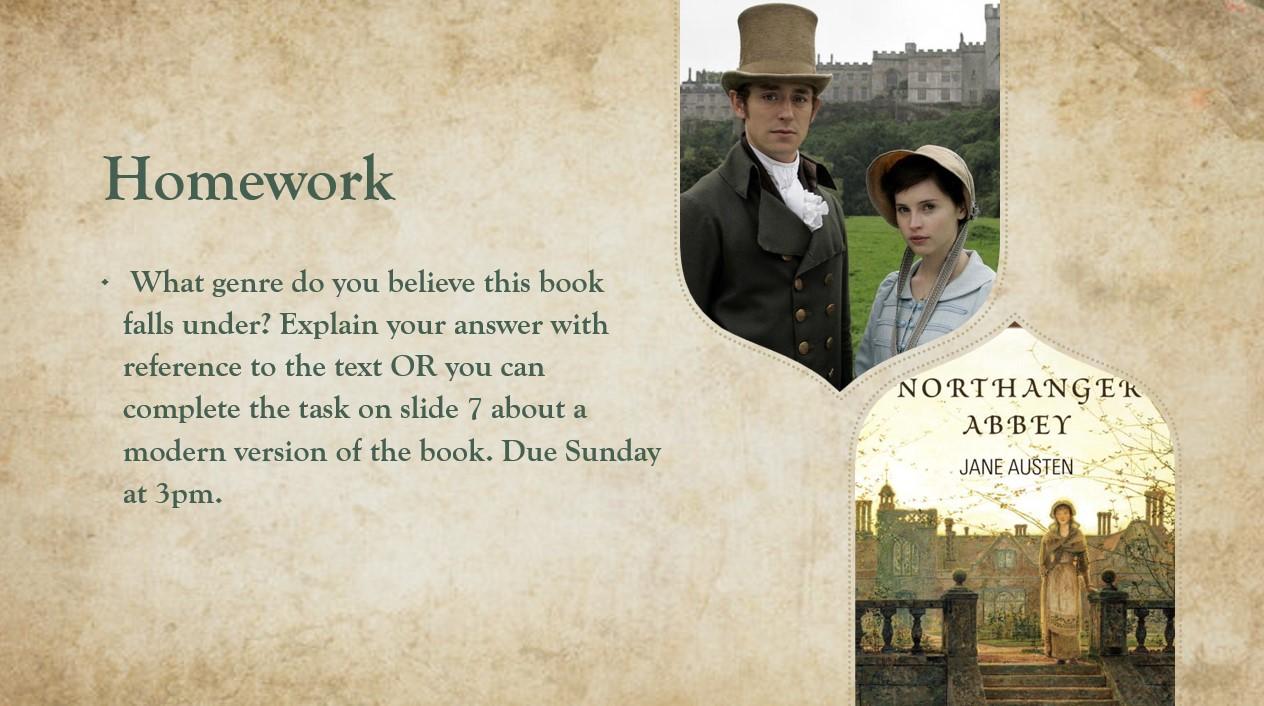
Attachments:
You must be logged in to view attached files. -
at 09:29 #26261
 AmberParticipant
AmberParticipantDear Beth,
Thanks as always forthe sur-awsome lesson🤩✨
———————————
Infographic by Amber⬇️⬇️⬇️
Attachments:
You must be logged in to view attached files.-
at 10:00 #26290
-
-
at 12:48 #26271
-
at 11:20 #26273
Yichen
ParticipantHi Beth,
Thanks for the tremendous lesson (as always)!😊Here is my homework – I did the one on slide 7 and I planned two novels, one was a modern version of Northanger Abbey, the other is my own idea.
Yichen
Attachments:
You must be logged in to view attached files.-
at 10:13 #26295
-
-
-
AuthorPosts
- You must be logged in to reply to this topic.
